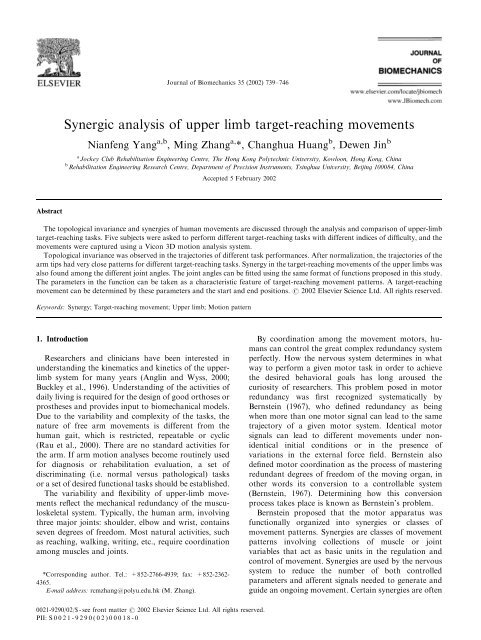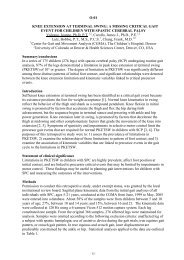Synergic analysis of upper limb target-reaching movements
Synergic analysis of upper limb target-reaching movements
Synergic analysis of upper limb target-reaching movements
Create successful ePaper yourself
Turn your PDF publications into a flip-book with our unique Google optimized e-Paper software.
Abstract<br />
Journal <strong>of</strong> Biomechanics 35 (2002) 739–746<br />
<strong>Synergic</strong> <strong>analysis</strong> <strong>of</strong> <strong>upper</strong> <strong>limb</strong> <strong>target</strong>-<strong>reaching</strong> <strong>movements</strong><br />
Nianfeng Yang a,b , Ming Zhang a, *, Changhua Huang b , Dewen Jin b<br />
a Jockey Club Rehabilitation Engineering Centre, The Hong Kong Polytechnic University, Kowloon, Hong Kong, China<br />
b Rehabilitation Engineering Research Centre, Department <strong>of</strong> Precision Instruments, Tsinghua University, Beijing 100084, China<br />
Accepted 5 February 2002<br />
The topological invariance and synergies <strong>of</strong> human <strong>movements</strong> are discussed through the <strong>analysis</strong> and comparison <strong>of</strong> <strong>upper</strong>-<strong>limb</strong><br />
<strong>target</strong>-<strong>reaching</strong> tasks. Five subjects were asked to perform different <strong>target</strong>-<strong>reaching</strong> tasks with different indices <strong>of</strong> difficulty, and the<br />
<strong>movements</strong> were captured using a Vicon 3D motion <strong>analysis</strong> system.<br />
Topological invariance was observed in the trajectories <strong>of</strong> different task performances. After normalization, the trajectories <strong>of</strong> the<br />
arm tips had very close patterns for different <strong>target</strong>-<strong>reaching</strong> tasks. Synergy in the <strong>target</strong>-<strong>reaching</strong> <strong>movements</strong> <strong>of</strong> the <strong>upper</strong> <strong>limb</strong>s was<br />
also found among the different joint angles. The joint angles can be fitted using the same format <strong>of</strong> functions proposed in this study.<br />
The parameters in the function can be taken as a characteristic feature <strong>of</strong> <strong>target</strong>-<strong>reaching</strong> movement patterns. A <strong>target</strong>-<strong>reaching</strong><br />
movement can be determined by these parameters and the start and end positions. r 2002 Elsevier Science Ltd. All rights reserved.<br />
Keywords: Synergy; Target-<strong>reaching</strong> movement; Upper <strong>limb</strong>; Motion pattern<br />
1. Introduction<br />
Researchers and clinicians have been interested in<br />
understanding the kinematics and kinetics <strong>of</strong> the <strong>upper</strong><strong>limb</strong><br />
system for many years (Anglin and Wyss, 2000;<br />
Buckley et al., 1996). Understanding <strong>of</strong> the activities <strong>of</strong><br />
daily living is required for the design <strong>of</strong> good orthoses or<br />
prostheses and provides input to biomechanical models.<br />
Due to the variability and complexity <strong>of</strong> the tasks, the<br />
nature <strong>of</strong> free arm <strong>movements</strong> is different from the<br />
human gait, which is restricted, repeatable or cyclic<br />
(Rau et al., 2000). There are no standard activities for<br />
the arm. If arm motion analyses become routinely used<br />
for diagnosis or rehabilitation evaluation, a set <strong>of</strong><br />
discriminating (i.e. normal versus pathological) tasks<br />
or a set <strong>of</strong> desired functional tasks should be established.<br />
The variability and flexibility <strong>of</strong> <strong>upper</strong>-<strong>limb</strong> <strong>movements</strong><br />
reflect the mechanical redundancy <strong>of</strong> the musculoskeletal<br />
system. Typically, the human arm, involving<br />
three major joints: shoulder, elbow and wrist, contains<br />
seven degrees <strong>of</strong> freedom. Most natural activities, such<br />
as <strong>reaching</strong>, walking, writing, etc., require coordination<br />
among muscles and joints.<br />
*Corresponding author. Tel.: +852-2766-4939; fax: +852-2362-<br />
4365.<br />
E-mail address: rcmzhang@polyu.edu.hk (M. Zhang).<br />
0021-9290/02/$ - see front matter r 2002 Elsevier Science Ltd. All rights reserved.<br />
PII: S 0021-9290(02)00018-0<br />
By coordination among the movement motors, humans<br />
can control the great complex redundancy system<br />
perfectly. How the nervous system determines in what<br />
way to perform a given motor task in order to achieve<br />
the desired behavioral goals has long aroused the<br />
curiosity <strong>of</strong> researchers. This problem posed in motor<br />
redundancy was firstrecognized systematically by<br />
Bernstein (1967), who defined redundancy as being<br />
when more than one motor signal can lead to the same<br />
trajectory <strong>of</strong> a given motor system. Identical motor<br />
signals can lead to different <strong>movements</strong> under nonidentical<br />
initial conditions or in the presence <strong>of</strong><br />
variations in the external force field. Bernstein also<br />
defined motor coordination as the process <strong>of</strong> mastering<br />
redundantdegrees <strong>of</strong> freedom <strong>of</strong> the moving organ, in<br />
other words its conversion to a controllable system<br />
(Bernstein, 1967). Determining how this conversion<br />
process takes place is known as Bernstein’s problem.<br />
Bernstein proposed that the motor apparatus was<br />
functionally organized into synergies or classes <strong>of</strong><br />
movement patterns. Synergies are classes <strong>of</strong> movement<br />
patterns involving collections <strong>of</strong> muscle or joint<br />
variables that act as basic units in the regulation and<br />
control <strong>of</strong> movement. Synergies are used by the nervous<br />
system to reduce the number <strong>of</strong> both controlled<br />
parameters and afferent signals needed to generate and<br />
guide an ongoing movement. Certain synergies are <strong>of</strong>ten
Table 3<br />
The parameters for the curves fitting<br />
Angles AZ EF EL FR RL<br />
A 0.3000 0.1000 0.7500 0.0100 1.5000<br />
k1 1.0077 0.5270 0.6761 0.5030 0.795<br />
k2 1.5708 4.7124 4.7124 4.7124 4.7124<br />
b1 0.0077 0.5280 0.6760 0.5027 0.7960<br />
b2 0 0 4.7124 0 4.7124<br />
study has the same or even better error level <strong>of</strong> the fifth<br />
order polynomial fitting. Higher order polynomial or<br />
other complex techniques may get the better fitting<br />
N. Yang et al. / Journal <strong>of</strong> Biomechanics 35 (2002) 739–746 745<br />
Fig. 9. Curve fitting for angles.<br />
Table 4<br />
The variances <strong>of</strong> the errors <strong>of</strong> fitting the angle curves<br />
Angles AZ EF EL FR RL<br />
Cov(a) 0.0010 0.0035 0.0030 0.0025 0.0026<br />
results, but the number <strong>of</strong> the fitting parameters will<br />
increase, and the parameters in such techniques (such as<br />
high-order polynomial) do nothave such regularity as<br />
parameters in Eq. (7) (scaling and translating parameters).<br />
It is difficult to use them to describe and define<br />
the synergies.
746<br />
The results in this paper can be widely used in many<br />
fields. The function description <strong>of</strong> arm <strong>movements</strong> can<br />
largely reduce the parameters required to simulate arm<br />
motion, and to control a powered <strong>upper</strong>-<strong>limb</strong> orthosis<br />
or robotarm.<br />
5. Conclusion<br />
It can be concluded that topological invariance and<br />
synergies can be found in <strong>target</strong>-<strong>reaching</strong> <strong>movements</strong> <strong>of</strong><br />
human <strong>upper</strong> <strong>limb</strong>s. The jointangles <strong>of</strong> the <strong>upper</strong> <strong>limb</strong><br />
can be described in the same format <strong>of</strong> functions. The<br />
<strong>movements</strong> can be determined by the parameters,<br />
together with the start and end positions. The above<br />
results can be applied widely in biomechanical modeling,<br />
orthoses design, control theory and rehabilitation<br />
evaluation.<br />
Acknowledgements<br />
The study was supported by RGC Direct Allocation<br />
(GrantNumber A-PC16), The Hong Kong Polytechnic<br />
University.<br />
References<br />
Anglin, C., Wyss, U.P., 2000. Review <strong>of</strong> arm motion analyses.<br />
Proceedings <strong>of</strong> the Institute <strong>of</strong> Mechanical Engineers Part H 214,<br />
541–555.<br />
Bernstein, N., 1967. The Coordination and Regulation <strong>of</strong> Movement.<br />
Pergamon Press, London.<br />
Buckley, M.A., Yardley, A., Johnson, G.R., Carus, D.A., 1996.<br />
Dynamics <strong>of</strong> the <strong>upper</strong> <strong>limb</strong> during performance <strong>of</strong> the tasks <strong>of</strong><br />
everyday living—a review <strong>of</strong> the current knowledge base. Proceedings<br />
<strong>of</strong> the Institute <strong>of</strong> Mechanical Engineers Part H 210, 241–247.<br />
Clark, J.E., Phillips, S.J., 1993. A longitudinal study <strong>of</strong> intra<strong>limb</strong><br />
coordination in the first year <strong>of</strong> independent walking: a dynamical<br />
systems <strong>analysis</strong>. Child Development 64, 1143–1157.<br />
N. Yang et al. / Journal <strong>of</strong> Biomechanics 35 (2002) 739–746<br />
Diedrich, F.J., Warren, W.H., 1995. Why change gaits? Dynamics <strong>of</strong><br />
the walk–run transition. Journal <strong>of</strong> Experimental Psychology 21,<br />
183–202.<br />
Flash, T., 1990. The organization <strong>of</strong> human arm trajectory control. In:<br />
Winters, J., Woo, S. (Eds.), Multiple Muscle Systems: Biomechanics<br />
and MovementOrganization. Springer, London, pp. 283–301.<br />
Horak, F.B., Diener, H.C., Nashner, L.M., 1989. Influence <strong>of</strong> central<br />
seton human postural responses. Journal <strong>of</strong> Neurophysiology 62,<br />
841–853.<br />
Kots, Y.M., Syrovegin, A.V., 1966. Fixed set <strong>of</strong> variants <strong>of</strong> interaction<br />
<strong>of</strong> the muscles <strong>of</strong> two joints used in the execution <strong>of</strong> simple<br />
voluntary <strong>movements</strong>. Biophysics 11, 1212–1219.<br />
Laquaniti, F., Soechting, J.F., Terzuolo, S.A., 1986. Path constraints<br />
on point-to-point arm <strong>movements</strong> in three-dimensional space.<br />
Neuroscience 17, 313–324.<br />
Li, L., Elizabeth, C.H., van den Bogert, Graham, E.C., Richard van,<br />
E.A.E., Joseph, H., 1999. Coordination patterns <strong>of</strong> walking and<br />
running atsimilar speed and stride frequency. Human Movement<br />
Science 18 (1), 67–85.<br />
Mah, C.D., Hulliger, M., Lee, R.G., Callaghan, I.S., 1994. Quantitative<br />
<strong>analysis</strong> <strong>of</strong> human movement synergies: constructive pattern<br />
<strong>analysis</strong> for gait. Journal <strong>of</strong> Motor Behavior 26 (2), 83–102.<br />
Nashner, L.M., McCollum, G., 1985. The organization <strong>of</strong> human<br />
postural <strong>movements</strong>: a formal basis and experimental synthesis.<br />
Behavioral and Brain Sciences 8, 135–172.<br />
Rau, G., Disselhorst-Klug, C., Schmidt, R., 2000. Movement<br />
biomechanics goes upwards: from the leg to the arm. Journal <strong>of</strong><br />
Biomechanics 33, 1207–1216.<br />
Romilly, D.P., Anglin, C., Gosine, R.G., Hershler, C., Raschke, S.U.,<br />
1994. A functional task <strong>analysis</strong> and motion simulation for the<br />
development <strong>of</strong> a powered <strong>upper</strong>-<strong>limb</strong> orthosis. IEEE Transactions<br />
<strong>of</strong> Rehabilitation Engineering 2 (3), 119–129.<br />
Schmidt, R., Disselhorst-Klug, C., Silny, J., Rau, G., 1999. A markerbased<br />
measurementprocedure for unconstrained wristand elbow<br />
motions. Journal <strong>of</strong> Biomechanicals 32, 615–621.<br />
Soechting, J.F., Laquaniti, F., 1981. Invariant characteristics <strong>of</strong> a<br />
pointing movement in man. Jouranl <strong>of</strong> Neuroscience 1, 710–720.<br />
Sporns, O., Edelman, G.M., 1993. Solving Bernstein’s problem: a<br />
proposal for the development <strong>of</strong> coordinated movement by<br />
selection. Child Development 64, 960–981.<br />
Winter, D.A., 1989. Biomechanics <strong>of</strong> normal and pathological gait:<br />
implications for understanding human motor control. Journal <strong>of</strong><br />
Motor Behavior 21, 337–356.<br />
Yang, J.F., Winter, D.A., Wells, R.P., 1990a. Postural dynamics in the<br />
standing human. Biological Cybernetics 62, 309–320.<br />
Yang, J.F., Winter, D.A., Wells, R.P., 1990b. Postural dynamics <strong>of</strong><br />
walking in humans. Biological Cybernetics 62, 321–330.
















